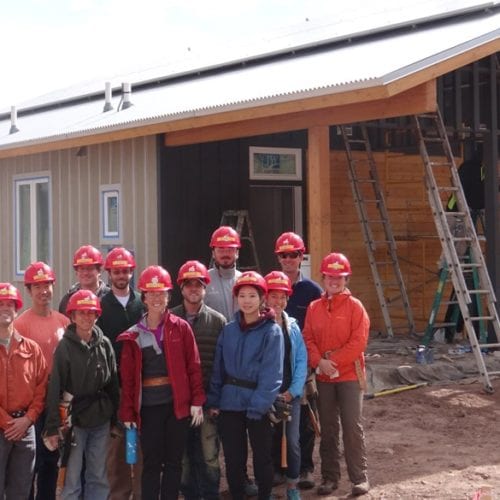Three multi-ethnic workers wearing hardhats and safety vests. The foreman is the Hispanic woman standing in the middle, laughing.

Job Creation through Building Electrification in California
California continues to lead the nation in accelerating the transition to an all-electric future, demonstrating foresight that will help the state achieve its climate and air quality goals and prepare to bounce back from the coming economic slump. Regulators recently approved two pilot projects that will advance the market for electric space and water heaters and provide funding for all-electric new homes, while 30 local jurisdictions throughout California have updated their building codes to require all-electric new construction.
Transitioning California’s buildings from fossil fuel to electric heating will take a dedicated workforce ready to meet the growing demand. Investing in new, sustainable jobs is now more critical than ever—both in California and nationwide—as unemployment claims rise and states brace for an economic downturn stemming from the current pandemic.
Building Electrification Pilot Projects
The California Public Utilities Commission (CPUC) decision comes out of legislation, Senate Bill 1477, and a regulatory proceeding to design programs that will help decarbonize buildings and support the state’s goal to reduce greenhouse gas emissions 40 percent below 1990 levels by 2030. Building electrification is widely recognized as a low-cost method to achieve greenhouse gas emissions reductions. It is also an essential strategy for reducing air pollution and safeguarding public health, especially in California where buildings contribute five times more air pollution than power plants.
The decision commits $200 million to two pilot programs: BUILD and TECH. The BUILD program will use $80 million of the funds to develop new all-electric homes with no gas hookups, and at least $60 million will support new low-income housing. A majority of the funding ($120 million) will go to the TECH program to accelerate market development and adoption of low-emissions space and water heating equipment in new and existing homes.
As Sierra Club and the Natural Resources Defense Council have explained, these programs will help address roadblocks that limit the adoption of electric space and water heaters, with initiatives to develop consumer awareness (including for hard-to-reach customers) and incentives for manufacturers. Of particular note, these programs have dedicated funding to train contractors about how and why to install electric appliances in homes.
All-Electric New Construction Is Trending Statewide
Meanwhile, new policies to advance all-electric new construction have become a statewide trend. Santa Cruz recently became the 30th city in California to pass an all-electric new construction requirement. Many other cities have announced plans to follow suit, describing the health, safety, climate, and economic benefits that they want to secure for their residents. As Rocky Mountain Institute research shows, all-electric new construction is cost-effective for consumers. For a single-family home in Oakland, for instance, we found that all-electric construction saves $2,000 over 15 years. Plus, a recent poll showed that most residents in California would prefer to power their homes with electricity rather than natural gas, even those that are unfamiliar with electric equipment. The increasing number of California cities adopting all-electric building codes, combined with consumer preferences and the CPUC’s commitment to funding building electrification, should send a signal to developers statewide that the new construction market is going all-electric.
Creating Job Opportunities
A statewide transition to all-electric buildings is going to require the talents and skills of workers from across the economy. A recent study found that electrifying all of California’s existing and new buildings by 2045 would create over 100,000 full-time equivalent jobs in various sectors of the economy. That 100,000 represents a net increase in jobs, even after accounting for losses in the fossil fuel industry. The research also shows that three out of every five of these new jobs will be in sectors that require and appropriately compensate a skilled and trained workforce .
Given this incredible opportunity for California’s economy, the state’s TECH and BUILD programs are both timely and vital. The state is struggling with economic uncertainty under the current shelter-in-place order that has shut down non-essential businesses in an effort to curb the spread of a global pandemic. The promise of new, sustainable jobs through building electrification becomes even more important in the face of an economic recession.
The CPUC allows considerable flexibility in how the TECH funds are spent, which presents an opportunity to support those in the workforce who are losing income from reduced work hours. Training and incentives could be set aside for contractors and tradespeople whose jobs have been most heavily impacted by the recent economic turmoil. The state could even begin to offer online training resources in the near term while construction jobs are put on hold. In the long term, California’s programs are well-designed to spur a market that will lead to significant job creation statewide, while promoting a cleaner, safer, and healthier future for all Californians.

